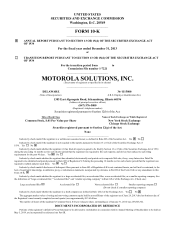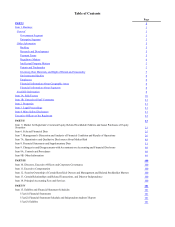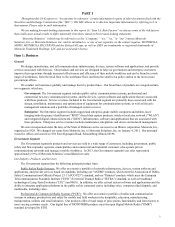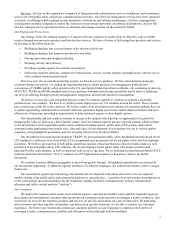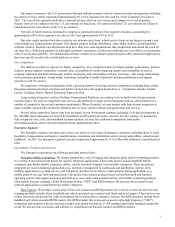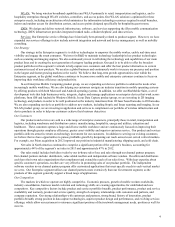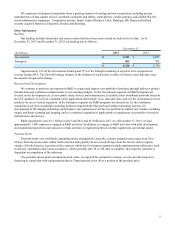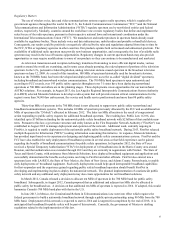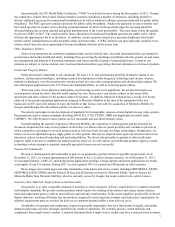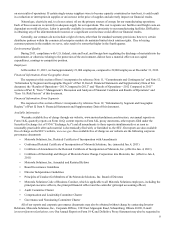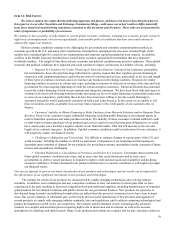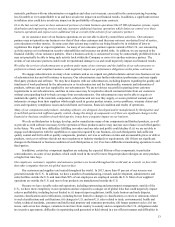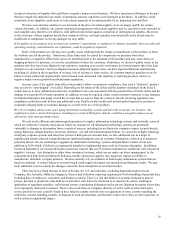Motorola 2013 Annual Report Download - page 9
Download and view the complete annual report
Please find page 9 of the 2013 Motorola annual report below. You can navigate through the pages in the report by either clicking on the pages listed below, or by using the keyword search tool below to find specific information within the annual report.7
Internationally, the ITU World Radio Conference ("WRC") was held in Geneva during the first quarter of 2012. During
this conference, leaders from United Nations member countries considered a number of initiatives, including whether to
allocate additional spectrum for commercial broadband use as well as whether to allocate spectrum dedicated for public safety
broadband. The WRC agreed to consider spectrum for public safety broadband. Studies are underway to assess whether and
how much spectrum is needed and to develop recommendations on where in the spectrum range the spectrum should be
allocated (taking into account regional and global harmonization to the extent practicable). The issue made it onto the agenda
for the next WRC in 2015. The result could be future allocations for dedicated broadband spectrum for public safety which
will provide opportunities for us in the future. In addition, certain countries already have spectrum landscapes that would
permit country administrations to allocate public safety spectrum today. A WRC initiative can spur individual countries to act
sooner, which may also create opportunities for our broadband solutions in the nearer term.
Other Regulatory Matters
Some of our operations use substances regulated under various federal, state, local and international laws governing the
environment and worker health and safety, including those governing the discharge of pollutants into the ground, air and water,
the management and disposal of hazardous substances and wastes and the cleanup of contaminated sites. Certain of our
products are subject to various federal, state, local and international laws governing chemical substances in electronic products.
Intellectual Property Matters
Patent protection is important to our operations. We have a U.S. and international portfolio of patents relating to our
products, systems and technologies, including research developments in radio frequency technology and circuits, wireless
network technologies, over-the-air protocols, mission critical two-way radio communications and advanced data capture. We
have filed patent applications in the U.S. Patent and Trademark Office, as well as in foreign patent offices.
We license some of our patents to third-parties, but licensing revenue is not significant. We are also licensed to use
certain patents owned by others. Royalty and licensing fees vary from year to year and are subject to the terms of the
agreements and sales volumes of the products subject to licenses. In addition, Motorola Solutions has a royalty free license
under all of the patents and patent applications assigned to Motorola Mobility at the time of the separation of the two
businesses in 2011 and will continue to enjoy the benefit of that license even with the acquisition of Motorola Mobility by
Google and following the sale of those patents to Lenovo or others.
We actively participate in the development of standards for interoperable, mission-critical digital two-way radio systems.
Our patents are used in various standards including APCO P25, ETSI, TETRA, DMR and digital private mobile radio
("dPMR"). We offer licenses to those patents on fair, reasonable and non-discriminatory terms.
Notwithstanding the transfer of patents to Motorola Mobility, the expiration of certain patents and the potential for
increased competition for some of our products in the future, we believe that our patent portfolio will continue to provide us
with a competitive advantage in our core product areas as well as provide leverage for future technologies. Furthermore, we
believe we are not dependent upon a single patent or a few patents. Our success depends more upon our extensive know-how,
innovative culture, technical leadership and marketing abilities. We do not rely primarily on patents or other intellectual
property rights to protect or establish our market position; however, we will enforce our intellectual property rights in certain
technologies when attempts to negotiate mutually agreeable licenses are not successful.
Patents and Trademarks
We seek to obtain patents and trademarks to protect our proprietary position whenever possible and practical. As of
December 31, 2013, we owned approximately 6,600 patents in the U.S. and in foreign countries. As of December 31, 2013,
we had approximately 2,400 U.S. and foreign patent applications pending. Foreign patents and patent applications are mostly
counterparts of our U.S. patents. During 2013, we were granted 300 U.S. patents and 400 patents in other countries.
We no longer own certain logos and other trademarks, trade names and service marks, including MOTOROLA, MOTO,
MOTOROLA SOLUTIONS and the Stylized M logo and all derivatives thereof (“Motorola Marks”) and we license the
Motorola Marks from Motorola Mobility, which is currently owned by Google, but under contract to be sold to Lenovo.
Inventory, Raw Materials, Right of Return and Seasonality
Our practice is to carry reasonable amounts of inventory to meet customers’ delivery requirements in a manner consistent
with industry standards. We provide custom products which require the stocking of inventories and a large variety of piece
parts and replacement parts in order to meet delivery and warranty requirements. To the extent suppliers’ product life cycles are
shorter than ours, stocking of lifetime buy inventories is required to meet long-term warranty and contractual requirements. In
addition, replacement parts are stocked for delivery on customer demand within a short delivery cycle.
Availability of materials and components required is generally dependable; however, fluctuations in supply and market
demand could cause selective shortages and affect our results of operations. We currently procure certain materials and
components from single-source vendors. A material disruption from a single-source vendor may have a material adverse impact

